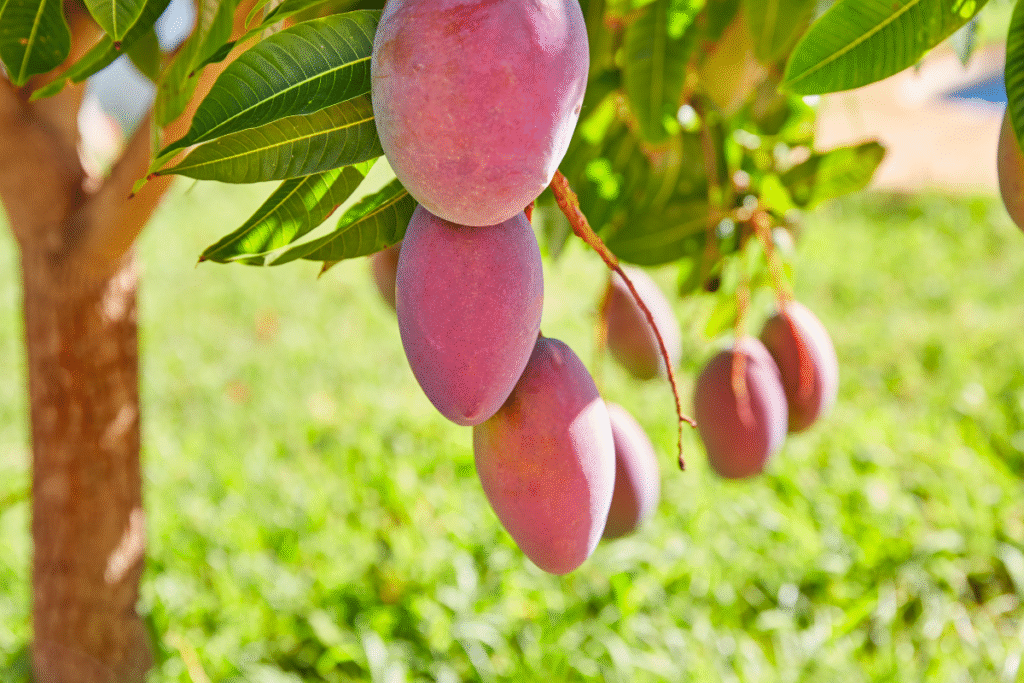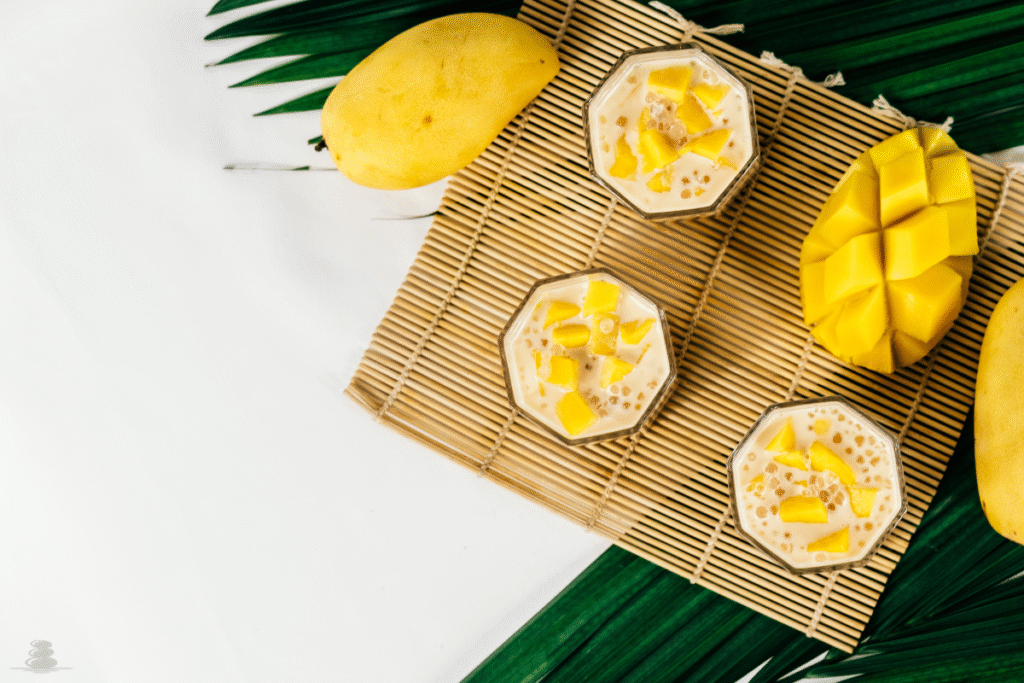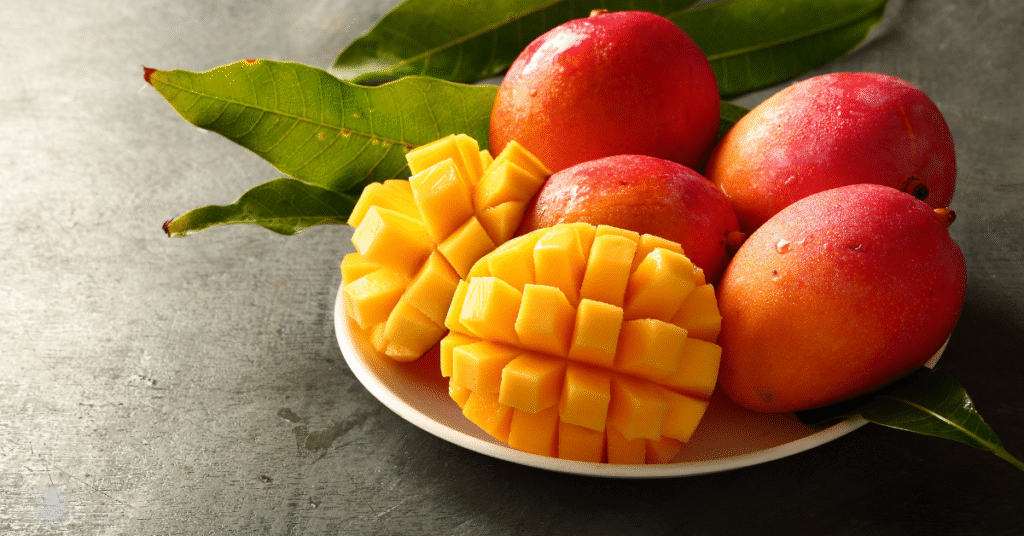Juicy, sweet, and packed with tropical flavor — mangoes are more than just a summer treat. They’re often referred to as the “king of fruits,” and it’s easy to see why. With their rich golden color, intoxicating aroma, and irresistible taste, mangoes have earned their crown not just in the fruit bowl, but also in cultures, cuisines, and wellness routines around the world.
But mangoes are more than just delicious. Behind their sweet flesh lies a fascinating history that dates back thousands of years, a journey that spans continents, and a nutritional profile filled with impressive mango nutrition facts that make them a powerhouse of health. Whether you enjoy them freshly sliced, blended into smoothies, or added to vibrant salads and curries, knowing how to eat mango properly can enhance your culinary experience.
Let’s examine some key mango nutrition facts that highlight its value.
Incorporating mangoes into your diet can be beneficial, as shown by mango nutrition facts.
In this article, you’ll dive deep into everything mango-related. From their ancient origins in South Asia to the tropical regions where the best mango varieties thrive today, we’ll explore how this fruit became a global favorite. You’ll discover the many ways to eat and store mangoes, learn about their impressive mangoes health benefits, and also understand the potential downsides if consumed excessively or by certain individuals.
Let’s explore more about the mango nutrition facts that make this fruit stand out.
Whether you’re a mango lover or just curious about including more tropical fruits in your diet, this complete guide will help you make the most of this beloved fruit — mindfully, healthfully, and deliciously.
Learning about mango nutrition facts can help you make informed dietary choices.
A Sweet History: Where Mangoes Come From
Mangoes have a fascinating history that stretches back thousands of years, making them one of the oldest cultivated fruits in human civilization. Originating from the lush regions of South Asia, primarily in India and Myanmar, mangoes were first domesticated over 4,000 years ago. These early mango trees quickly became integral to the cultures they touched.
In India, mangoes are considered sacred and symbolize fertility, love, and prosperity. Ancient Indian scriptures and classical poetry often celebrate mangoes, and the fruit is associated with religious rituals and festivals. The mango tree itself is revered, often planted near temples and homes as a sign of good fortune.
By the early centuries CE, mango cultivation spread across Asia through trade routes, reaching Southeast Asia and China. The Persian Empire played a crucial role in introducing mangoes to the Middle East and parts of Africa around the 10th century, facilitating the fruit’s gradual expansion westward.
The age of exploration in the 15th and 16th centuries brought mangoes to the Americas. Portuguese sailors and colonists introduced mango trees to Brazil, the Caribbean, and eventually to Mexico, Central America, and southern parts of the United States. This global journey transformed the mango into a true world fruit.
Today, mangoes are cherished worldwide — in tropical climates and far beyond — carrying centuries of cultural significance and agricultural heritage.
Where Mangoes Grow Today
Mangoes thrive best in warm tropical and subtropical climates where temperatures typically stay above 24°C (75°F). They require a frost-free environment, plenty of sunshine, and well-drained soil to flourish.
Leading Mango Producers:
- India dominates mango production, growing a staggering variety of over 1,000 types, from the juicy Alphonso to the fibrous Dasheri. India alone produces over 40 million tons annually.
- Mexico is the world’s largest exporter of mangoes, with varieties like Ataulfo and Kent popular in North America.
- Thailand, Indonesia, and the Philippines are known for unique mango types like the Nam Dok Mai and Carabao.
- Pakistan produces rich and flavorful mangoes such as Sindhri and Chaunsa.
- Other notable growers include Brazil, Egypt, South Africa, Australia, and the United States (notably Florida and California).
The mango tree itself is hardy and can live for decades, producing fruit for 40-50 years or more under optimal conditions. Its adaptability to various soil types and resistance to drought once established make it a valuable crop for many developing nations.
Each mango variety has its own mango nutrition facts contributing to its unique profile.
Best Mango Varieties Around the World

Mangoes come in a dazzling variety of shapes, sizes, colors, and flavors — each with its own unique charm. Some varieties are prized for their sweetness and buttery texture, while others are loved for their tartness or fiber-free flesh. Here are some of the most popular and delicious mango varieties grown around the world:
1. Alphonso (India)
Often called the “King of Mangoes,” Alphonso mangoes are celebrated for their rich, creamy texture and intense sweetness. They have a fragrant aroma and a perfect balance of tartness, making them a favorite for fresh eating and desserts. Alphonso mangoes are mostly harvested between April and June and are highly sought after internationally.
2. Ataulfo (Mexico)
Also known as Honey or Champagne mango, Ataulfo mangoes are smaller, with a golden-yellow skin and a buttery, smooth flesh. Their sweetness and creamy texture make them perfect for eating fresh or blending into smoothies. Ataulfo mangoes are usually available from March to July.
3. Kent (Mexico, Peru, Ecuador)
Kent mangoes are large and oval with green skin that often has a red blush. They are juicy and sweet with minimal fiber, making them ideal for fresh eating, salads, and juices. Kent mangoes are in season from late winter through summer.
4. Haden (Florida, USA)
Haden mangoes have a bright red skin with green and yellow highlights. They have a rich, sweet flavor but contain some fibrous strands. Haden mangoes are widely grown in Florida and are popular in North America, usually available from April to June.
5. Tommy Atkins (USA, Brazil, Mexico)
Tommy Atkins is one of the most commercially grown mangoes worldwide due to its long shelf life and resistance to disease. It has a firm flesh with mild sweetness and a fibrous texture. Its skin is green with red and orange blushes. Tommy Atkins is a versatile mango found year-round in many markets.
6. Keitt (Florida, USA)
Keitt mangoes are large with a green skin even when ripe. They have juicy, sweet flesh and low fiber, making them excellent for eating fresh and in recipes. They are typically available from late summer into fall.
7. Carabao (Philippines)
Also known as the Manila mango, Carabao mangoes are known for their incredibly sweet and fragrant flesh with almost no fiber. They have a bright yellow skin and are a beloved variety in Southeast Asia.
8. Sindhri (Pakistan)
Sindhri mangoes are large and oval with a sweet, aromatic, and juicy flesh. They have a golden yellow skin when ripe and are harvested mainly in May and June.
Each variety offers a different experience in flavor and texture, so exploring them is part of the joy of enjoying mangoes. Whether you prefer the rich creaminess of Alphonso or the tangy sweetness of Ataulfo, there’s a mango out there for every palate.
Mango Nutrition Facts: What’s Inside This Tropical Powerhouse?
Mangoes are not only delicious but also packed with nutrients that support overall health. Here’s a breakdown of the key nutrition facts for one cup (about 165 grams) of fresh mango slices:
- Calories: 99
- Carbohydrates: 25 grams
- Fiber: 2.6 grams
- Sugars: 23 grams (natural fruit sugars)
- Protein: 1.4 grams
- Fat: 0.6 grams
Vitamins and Minerals:
- Vitamin C: 60.1 mg (about 67% of the daily recommended intake) — boosts immunity and acts as a powerful antioxidant.
- Vitamin A: 89 mcg — important for vision, skin health, and immune function.
- Vitamin E: 1.5 mg — supports skin and eye health.
- Vitamin K: 6.9 mcg — essential for blood clotting and bone health.
- Folate (Vitamin B9): 71 mcg — important for cell division and DNA synthesis.
- Potassium: 277 mg — helps regulate blood pressure and heart function.
- Magnesium: 18 mg — supports muscle and nerve function.
Antioxidants:
Mangoes contain several antioxidants, including mangiferin, quercetin, and beta-carotene, which help protect the body from oxidative stress and inflammation.
Why These Nutrition Facts Matter
The high vitamin C content in mangoes supports immune health, helps the body absorb iron from plant-based foods, and promotes healthy skin. The fiber aids digestion and can help regulate blood sugar levels. Plus, the natural sweetness provides a healthier alternative to processed sugars.
Including mangoes in your diet can contribute to a balanced intake of essential nutrients while satisfying your sweet tooth naturally.
How to Eat Mangoes
Mangoes offer a sensory delight — their flavor ranges from intensely sweet to subtly tangy, and the texture can vary from buttery smooth to slightly fibrous, depending on the variety.
How to Cut a Mango:
Mangoes have a large, flat seed in the center, so the typical method is to slice the fruit into two “cheeks” on either side of the seed. After scoring the flesh in a crisscross pattern, you can easily scoop out the cubes or peel the skin and slice the flesh.
Popular Ways to Enjoy Mango:

As you explore mangoes, remember the key mango nutrition facts.
- Fresh and raw: Simply peel and slice for a refreshing snack or add to fruit salads.
- Smoothies and bowls: Mango blends beautifully into creamy smoothies, often paired with banana, coconut, or spinach.
- Mango lassi: A traditional Indian yogurt drink flavored with mango pulp, cardamom, and sometimes rose water.
- Mango salsa: Combine diced mango with red onion, cilantro, lime, and jalapeño for a vibrant topping perfect for grilled meats or fish.
- Salads: Mango adds a tropical twist when tossed with greens, nuts, and light vinaigrettes.
- Grilled: Grilling mango caramelizes its sugars and adds smoky notes—great as a side or dessert.
- Curries and chutneys: Mango balances spicy flavors when cooked into Indian or Southeast Asian dishes.
- Desserts: Mango is often used in puddings, ice creams, cakes, and frozen treats.
Unripe Mangoes:
Green mangoes are tart and firm and frequently used in pickles, salads (like Thai green mango salad), or chutneys, adding a bright acidity and crunch to dishes.
How to Store Mangoes
Proper storage is key to enjoying mangoes at their best.
Unripe Mangoes:
If your mango is firm and not yet fragrant, it’s unripe. Store it at room temperature to allow it to ripen naturally. To speed up the process, place it in a paper bag along with an ethylene-producing fruit like a banana or apple, which releases a natural gas that promotes ripening.
Ripe Mangoes:
Once ripe, mangoes should be moved to the refrigerator to slow down further ripening and prevent spoilage. At this stage, mangoes yield slightly to gentle pressure and smell sweet at the stem end. Stored properly, ripe mangoes will last about 5 to 7 days in the fridge.
Freezing Mangoes:
For longer storage, peel and dice mangoes before freezing. Spread the pieces on a baking tray to freeze individually before transferring them to an airtight container or freezer bag. Frozen mango is perfect for smoothies, sorbets, or quick desserts.
Health Benefits of Mangoes
Mangoes are not only delicious but also packed with essential nutrients and compounds that contribute to overall health.
1. Rich in Vitamins & Antioxidants
Mangoes are an excellent source of vitamin C, providing over 60% of the daily recommended intake in one cup. Vitamin C supports immune function, collagen synthesis, and wound healing. They also contain vitamin A in the form of beta-carotene, which is vital for eye health and skin maintenance.
Additionally, mangoes boast an array of antioxidants like polyphenols and flavonoids that help protect cells from oxidative stress and inflammation.
2. Supports Digestion
Mangoes contain digestive enzymes, such as amylases, that help break down complex carbohydrates. Their fiber content aids bowel regularity and promotes a healthy gut microbiome.
3. Boosts Immunity
The combination of vitamins A, C, and various antioxidants helps strengthen the immune system and reduce the risk of infections.
4. Heart Health
Potassium and magnesium in mangoes help regulate blood pressure and maintain healthy heart function. Fiber may also help lower cholesterol levels.
5. Skin & Hair Benefits
Vitamin A and C contribute to skin hydration and elasticity by supporting collagen production. These vitamins also promote healthy hair growth and scalp maintenance.
6. Hydration & Energy
Mangoes have high water content and natural sugars that provide hydration and quick energy, making them a great natural snack for active lifestyles.
Contraindications & Precautions
While mangoes are generally safe and healthy, some people should be mindful of the following:
1. High Natural Sugar Content
Rich in nutrients, the mango nutrition facts highlight its importance in nutrition.
Being aware of mango nutrition facts ensures you reap the most benefits.
Mangoes have a high glycemic index due to their natural sugars, which may lead to blood sugar spikes. Those with diabetes or insulin resistance should consume mangoes in moderation and pair them with protein or fats to balance blood sugar response.
2. Allergic Reactions
Some individuals are allergic to compounds in mango skin or sap, particularly urushiol, which can cause dermatitis or contact allergic reactions. If you experience itching or rash after handling mango skin, it’s best to avoid contact or wear gloves.
3. Digestive Discomfort
Overconsumption of mangoes, especially on an empty stomach, may cause digestive issues like bloating, gas, or diarrhea due to the fruit’s fiber and sugar content.
Pro Tips for Healthy Mango Enjoyment
- Combine mango with healthy fats or protein (like nuts or yogurt) to slow sugar absorption.
- Use mango as a natural sweetener instead of refined sugars in recipes.
- Choose green mango for savory dishes or pickles to reduce sugar intake.
- Freeze mango chunks to make refreshing and healthy frozen snacks.
- Remember that moderation is key to enjoying mangoes without adverse effects.
Images: Canva



